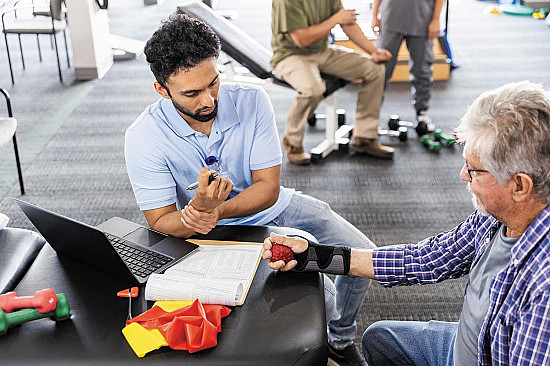Forearm workouts: Strengthening grip for everyday function
- Reviewed by Robert H. Shmerling, MD, Senior Faculty Editor, Harvard Health Publishing; Editorial Advisory Board Member, Harvard Health Publishing

When you think about building strength, your mind might immediately go to strength-training workouts for the larger muscles in your body such as your back, chest, or legs.
But the muscles of the forearm — the part of the arm that extends from the elbow to the wrist — are also worth paying attention to.
Why grip strength matters
Strong forearms support grip strength, which plays an important role in how well you can grasp and hold items. Think squeezing a tube of toothpaste, turning a doorknob, or holding a glass of water.
Research has also found that grip strength is associated with many measures of overall health, especially as you age. A weak grip is associated with:
- lower total strength
- reduced bone mineral density
- falls and fractures
- sleep problems
- memory problems
- depression
- malnutrition
- death from any cause.
How strengthening forearms can improve grip
Many of the muscles that help your hand and wrist grip something solidly extend into your forearms. One study found that having larger forearm muscles was correlated with greater grip strength. Strengthening forearm muscles can help you perform gripping and grasping movements more effectively and efficiently
As of now, there's no evidence that building forearm muscles and grip strength will improve longevity or overall health. However, increased grip strength will support your ability to perform gripping and grasping tasks — from opening jars to holding a cane and opening doors — that could help you stay independent longer.
Simple forearm exercises to boost grip strength
Some of the best forearm workouts involve surprisingly simple movements. Start with one set of 10 repetitions for each of the following strength exercises. Build up to two to three sets over time.
You'll need a set of light dumbells (1 to 3 pounds) and some therapy putty (start with the softest putty), which you can purchase at a medical supply store, to perform these exercises.
Wrist extension and flexion

- Hold a light dumbbell (1 to 3 pounds) in each hand.
- Keep your arms at your sides with your elbows bent, palms facing down.
- Moving from your wrist, lift the weights upward until you feel a gentle stretch on the inside of your wrist.
- Hold for a count of five.
- Then bend your wrist and lower the weights down until you feel a gentle stretch on the outside of your wrist.
- Hold for a count of five.
- Continue for 10 repetitions.
Wrist supination/pronation

- Hold a light dumbbell (1 to 3 pounds) in each hand.
- Keep your arms at your sides with your elbows bent, palms facing down.
- Rotate your forearm, so your palm faces up. Hold for a count of five.
- Then rotate your forearm so your palm faces down. Hold for a count of five.
- Continue for 10 repetitions.
Putty grip

- Roll the putty into a ball.
- Place the putty in your palm.
- Gently squeeze and release.
- Repeat 10 times on each hand every other day.
Putty three-point pinch

- Roll the putty into a short, fat cylinder.
- Place the putty between the pads of your thumb and your index and middle fingers.
- Gently squeeze the putty between your fingers and thumb and release.
- Repeat 10 times on each hand every other day.
Some people also use tools called hand grippers or grip strengtheners for a few minutes each day to build grip strength. There are many different models available online and in fitness stores.
Gadgets to help compensate for reduced grip strength
Forearm workouts only go so far. Sometimes you need a little assistance to accomplish tasks like opening a stubborn jar or confidently holding a sharp knife.
There are a number of tools and gadgets that can help. These are often available at medical supply stores or online. They include:
- electric can openers
- jar key openers
- nonslip gripper mats to open jars
- rocker knives
- dental floss holders
- soap-on-a-rope
- shoehorns
- doorknob extenders
- book stands
- nonslip gloves.
About the Author

Sarah Klein, Health Writer
About the Reviewer

Robert H. Shmerling, MD, Senior Faculty Editor, Harvard Health Publishing; Editorial Advisory Board Member, Harvard Health Publishing
Disclaimer:
As a service to our readers, Harvard Health Publishing provides access to our library of archived content. Please note the date of last review or update on all articles.
No content on this site, regardless of date, should ever be used as a substitute for direct medical advice from your doctor or other qualified clinician.















